"Capon in the style of Catalonia." A capon stuffed with sausage, pork, pig's ear, peaches, prunes, pine nuts and beans and then roasted.
The capulin cherry is native and common throughout the Valley of Mexico from Sonora to Chiapas and Veracruz and possibly western Guatemala. It has been cultivated since early times and is extensively naturalized in Central America and over much of western South America. Today it is cultivated in the Andes more than in its northern homeland and at harvest the fruits are abundantly available in Andean markets. The tree was introduced into California sometime after the mid-1920s. As many as 15 or 20 fruits sometimes develop on a raceme, but half or more fall before reaching maturity. Depending on climate and variety, they ripen from mid-May to midsummer. Resembling the northern cherry, the fruits are 1/2 to 3/4 inch in diameter and deep glossy maroon to dark purple in color, with a thin, tender skin. The pale green, firm, juicy flesh is sweet and agreeable with a touch of astringency similar to wild cherries in some cases. The pit is rather large in proportion to the size of the fruit. The trees will produce fruit 2 to 3 years after planting, and under the right conditions will set more than one crop per season. For reasons unknown trees with gray bark seem to produce larger fruit than those with darker bark.

Persimmon. Date plum. Kaki. A soft, sweet winter fruit similar to a large tomato, originating in China and unknown in Europe until shown in Paris in 1873. It has green skin which ripens to a glossy orange red. It is eaten as a dessert in fruit salads or used in jam (US: jelly).